Tool-using Wrens
Things to notice, and some early garden notes
The Doorstep Drummer
It’s interesting how even the wildest of creatures can take on perceived personalities if you spend enough time observing their activities. Recently we have been a bit disturbed by periods of steady tap-tap-tapping coming from somewhere around the back door leading from the kitchen to our deck. It is mid winter but we have a had few brief days of early thaw and so we rather naturally gravitated towards thoughts that there is perhaps a leak of water somewhere.
But where? We couldn’t find it.
A few days ago it got quite loud and persistent. I went to the back door and peered through the glass panel - it seemed that the sound was coming from low down. No sign of a drip. Getting as close as I could to the glass in the upper part of the door I tried to look down. Nothing, so I reached for the key and started turning it, intending to go out and look. It made a small noise as keys do when turned and there was movement down there, almost out of sight. Coming into view I saw the drummer. A small Carolina Wren had stepped back and was looking up at me peering down at it. The Wren had been tapping its beak on the metal outer doorstep. But why? The ways of Wrens are mysterious, and there he was staring at me and clearly sending strong “go away” thoughts in my direction.
Eventually, we managed to find a vantage point that allowed us to watch the doorstep but not scare the bird. So this is the story … he/she is collecting peanuts from our feeders, carrying them one by one to the door and wedging them into the corner of the doorstep where they cannot roll around, He then hacks flakes off the peanuts to eat. If that isn’t another example of a bird using what is, in effect, a tool then I don’t know what is. Impressive and not a fluke. He/she has been doing it for days. It is well known that Corvids in particular may use “tools” but I am not aware of such activity in birds such as this … I choose to use the word “tool” because the two birds are deliberately and repetitively taking a food item and transporting it to a place where it can be wedged and held still, the better to break up and eat. That corner, in this context, becomes a tool with a purpose. Clever.
Half an hour later … tap-tap-tap again but this time coming from the lower door to the back garden, some ten feet to the south. The Wren was certainly intent on his musical improvisation.
Then again … maybe he just likes playing the drums?
Enough of that - on now to what you came here for:
Whilst Out Walking, what’s to be seen?
It has to be admitted that walks at this time of the year are more about getting outside and enjoying mild exercise than they are about serious hope of finding new and exciting things. Few plants are of particular interest, unless tree bark is your thing. Some birds, most of which I have already introduced you to, will be around but as old friends rather than new and exciting arrivals. However, the absence of leaves and greenery does mean that there are some things that are easier to see, to notice, just now. For example …
Lichens
Technically, lichens are “lichen is a hybrid colony of algae or cyanobacteria living symbiotically among filaments of multiple fungi species, along with yeasts and bacteria embedded in the cortex or "skin", in a mutualistic relationship“ but for the purposes of today’s newsletter they are just something interesting, and sort-of greenish to be looking out for on our walks. Precise identification of lichens is, in general, not for the amateur. These examples found locally are Common Geenshield Lichen, one of the Sunburst Lichens (Family Teloschistaceae) and Boreal Oakmoss
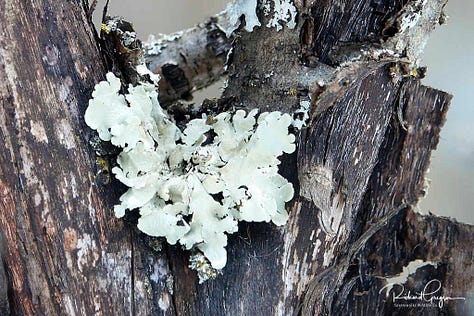
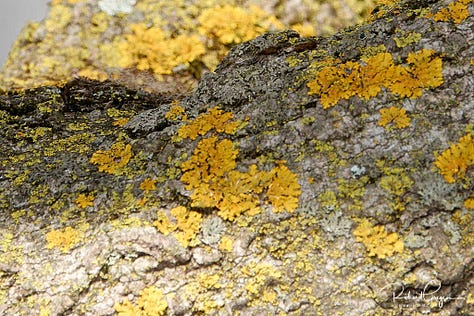
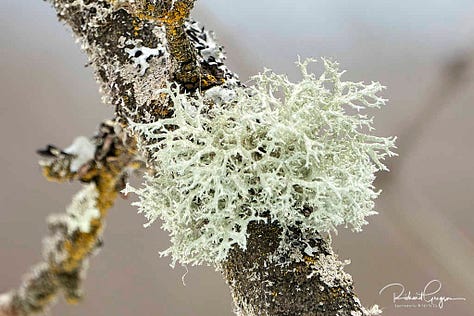
Occasionally we might see - Fancy Fungi
We found this specimen of Irpiciporus mollis, a shelf fungus. Also known as the marshmallow polypore. Instead of having the usual pores underneath the cap, this species has “teeth” and does look somewhat like a marshmallow squashed onto the bark of a tree. They are a parasitic species found on hardwoods, particularly oak trees. It causes a white heart rot when on living trees and also exploits decaying organic wood in dead specimens.
There are also things that are as likely to have noticed us, as we them.
Skunk in snow
“Just going about my business, busy busy, things to do”
Waxwings
Here is part of a small group of Cedar Waxwings finding something to eat on the branches of an exposed bush - wrinkled and frozen fruits. Very much a favourite bird, with their smart and well defined plumage.
… in a garden more than anywhere, understand that life is about patience and that hiding in plain sight in the galaxy of distractions are countless little miracles you can lose yourself in: a mere snowdrop or the first yellow flower on a forsythia. Unfortunately, both of these things herald the coming of spring. Everything is going to start growing again. Now, before it is too late, where in God’s name have I left my spade?
– found in The Guardian
Please have a look at the following article which contains something important to think about when planting native species in our gardens - the title says is well:
Good intentions, harmful impacts - the dangers of wildflower seed mixes. Wildflower doesn't necessarily mean native flower. Find out what's in your seed packet before unintentionally planting problems.
How to make a good frog pond
Neglected Species
Most conservation funds go to large vertebrates - the famous charismatic megafauna - at the expense of many ‘neglected’ species
No surprises really
“Nearly 94% of species identified as threatened, and thus at direct risk of extinction, received no support,” said Benoit Guénard, the lead author of the study. “Protecting this neglected majority, which plays a myriad of roles in ecosystems and represents unique evolutionary strategies, is fundamental if our common goal is to preserve biodiversity … Scientists have found that of the $1.963bn allocated to projects worldwide, 82.9% was assigned to vertebrates. Plants and invertebrates each accounted for 6.6% of the funding, while fungi and algae were barely represented at less than 0.2%. Disparities persisted among vertebrates, with 85% of all resources going to birds and mammals, while amphibians received less than 2.8% of funding.
Biodiversity Loss
Biodiversity loss is not only about losing species but also losing entire and essential ecosystems


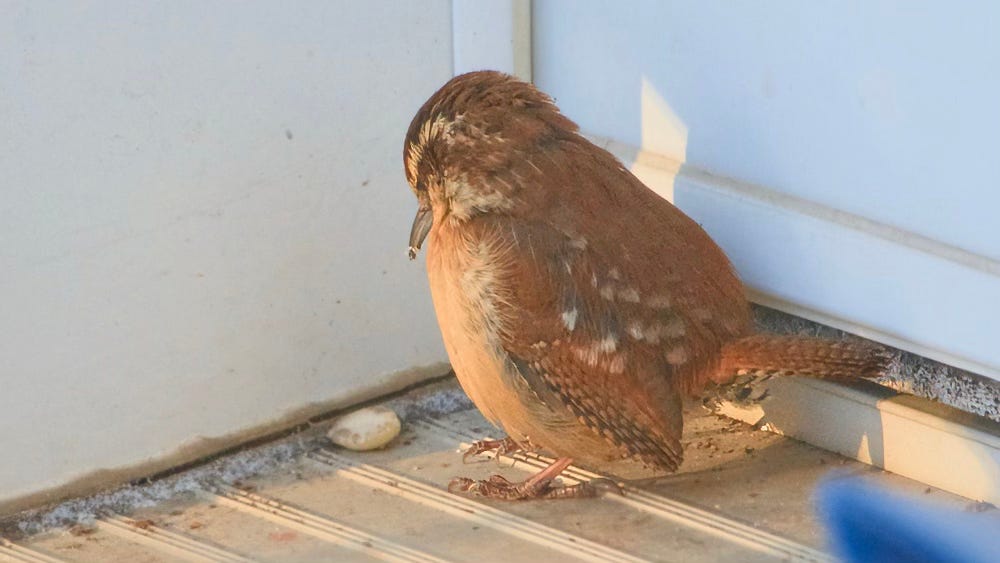


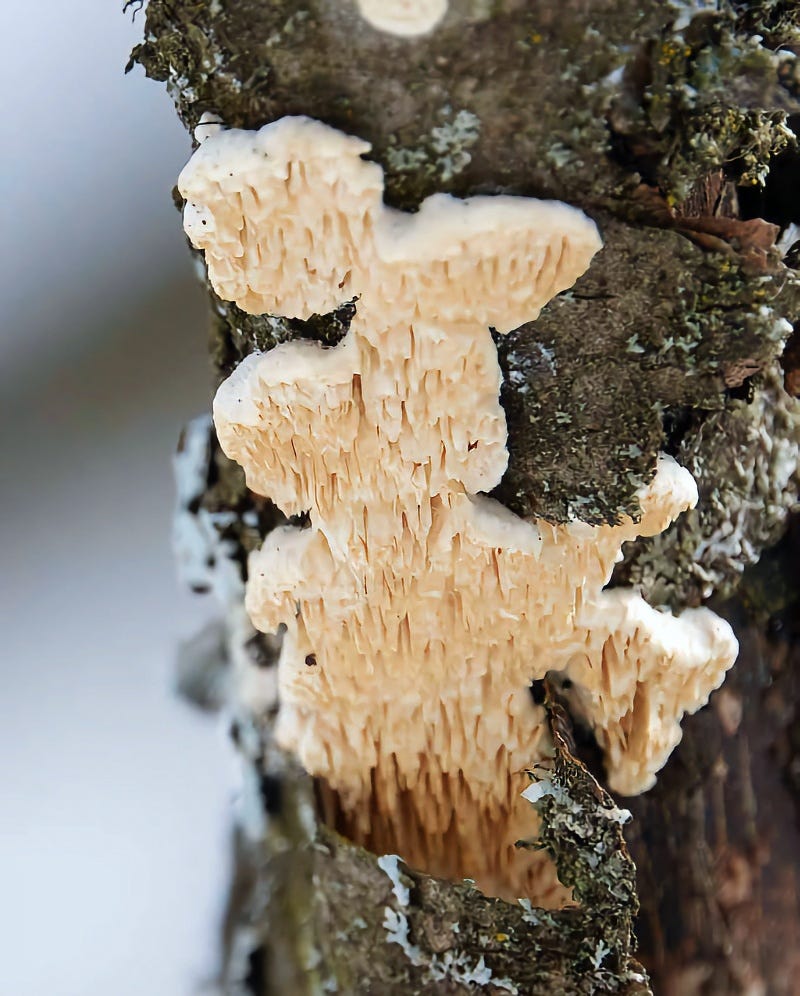
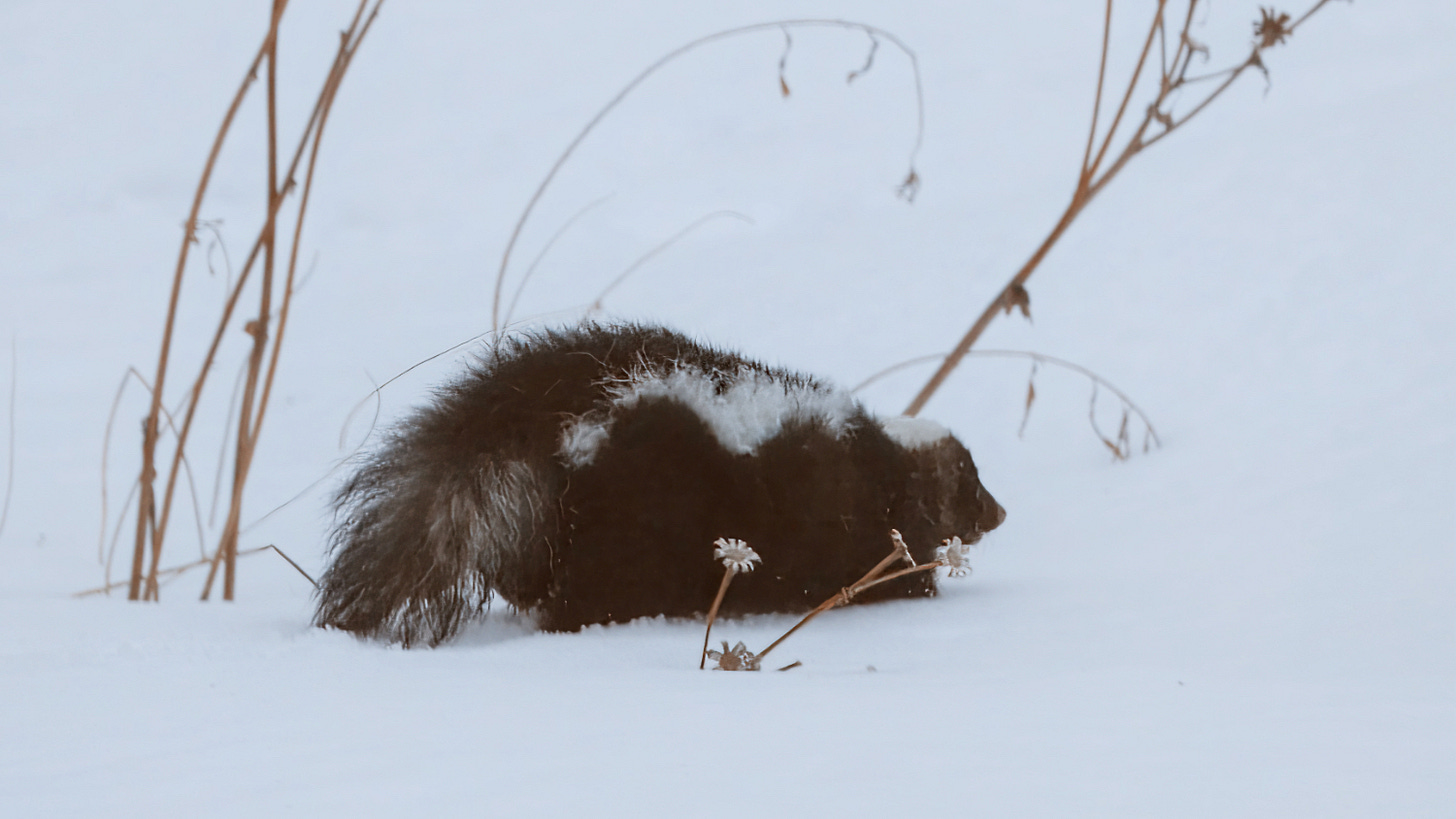








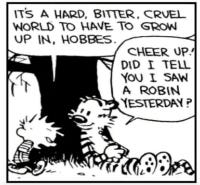
Thank you Ricard and Jean. We had a Downy picking at the window frames, finding overwintering insects in cracks, we believe. Just a few small holes so little damage. The Carolina Wren sometimes flies to the base of the house after it leaves the feeder, skulking I expect. Bob
Great text and logo!